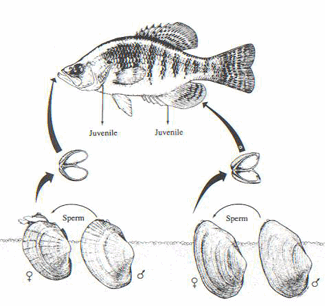Life
Cycle of Freshwater Mussels
by Robert E. Warren
ISM Associate Curator of Anthropology
 How
Do Mussels Reproduce?
How
Do Mussels Reproduce?
The mussel's reproductive system is elaborate. Generally the male fertilizes
the female's eggs during an annual spawning period. The fertilized eggs
(called larvae oe glochidia) then grow and develop in
the mother mussel's gills. Once they are released from their mother,
the larvae generally must attach to a fish or they will die. The larvae
live as parasites on the gills or
fins of the host fish
until they undergo
metamorphosis and transform
into juvenile mussels. The
juveniles then drop from the fish
to begin living independently.
Illustration
above: Life cycle of freshwater mussels (Cummings and Mayer, 1992)
How Do Mussels
Attract Host Fish?
Mussels use an amazing variety of strategies to attract host fish to their
larvae.
The Lure Strategy. In some species, the pregnant female mussel
lures fish by wiggling special mantle flaps that look like small minnows.
When a fish attacks the mother's lure, she releases larvae that attach
to the fish's gills.
The Bait Strategy. Other species create bags of larvae (called ovisacs
or superconglutinates) that mimic worms or larval fish. The mother
either reels out the bag on the end of a line (like a fisherman) or
the bag is released and glues itself to a rock. When a fish attacks
the bait, the bag ruptures and larvae attach to a fish's gills.

Illustration:
Ovisacs of the Ouachita kidneyshell mussel (Ptychobranchus
occidentalis) attached to a rock. The fish, a rainbow darter (Etheostoma
caeruleum) thinks the ovisacs look like larval fish and is about to try
one.
Illustration:Closeup of two Ouachita kidneyshell (Ptychobranchus
occidentalis) ovisacs. Note the pigmented "eyespots" and "mouths."
Illustration:Each
Ouachita kidneyshell (Ptychobranchus occidentalis) ovisac is a
bag containing several hundred mussel larvae. When the bag ruptures, the
released larvae will attempt to attach to the gills of a fish host.
The Net Strategy. The larvae of some mussels have long filaments
(byssus threads) or occur in long mucus strands. When the female
releases them, the filaments or strands intertwine to form "nets." When
a fish swims into a net, the larvae attach to its fins.
Illustration: Mucus strand of the creeper mussel
(Strophitus undulatus). The gaping valves of the mussel's microscopic
larvae are ready to attach themselves to the fins of a host fish.
Why
Do Mussel Larvae Attach to Fish Hosts?
One theory is that fish provide a good way for mussel populations to
disperse in the environment. By hitchhiking on swimming fish, mussel
larvae can expand the range of a mussel species into new rivers.
Illustration:
The Brown Bullhead (Ictalurus nebulosus) is a fish host of the
washboard (Megalonaias nervosa) and pimpleback (Quadrula pustulosa)
mussels.
Do
Male and Female Mussels Look the Same?
The reproductive tissues of male and female mussels differ from one
another but in many cases the shells look the same. However, in some
species male and female shells look very different (sexually dimorphic).
In sexually dimorhpic species, the shells of mature females are often
expanded in the posterior-ventral area. Why? In these species only the
posterior halves of the female's outer gills become engorged with larvae.
Her shell grows larger in this area to protect her gills and her offspring.
Illustration: Photos of male
and female oyster
mussels (Epioblasma capsaeformis).
Related
Activities:
Mussel Life Cycle (html)
(pdf)

